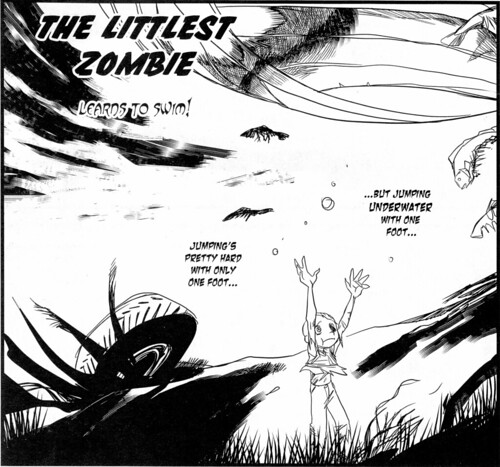Posted By John Sears on December 4, 2010
The Prometheus Project, also apparently named The Frankenstein Syndrome, was the big feature length film to deal with the Differently Animated at the Dark carnival this year (or so we thought going in) As the new, second title suggests, the trailer for this movie is a bit misleading, and it’s much closer to a modern Frankenstein story than it is to a Zombie tale. However, the ZRC likes to take an expansive view of our clientele, and so we would be happy to represent, say, Frankenstein’s ‘Monster’, neck bolts or no neck bolts, should he require our aid. Heck, he’s even green in some depictions, right? Thus we were eager to review this movie.
Unfortunately, despite being a modern spin on the Frankenstein tale (rather than a Zombie film as we previously thought),
it *still* isn’t really about the Differently Animated.
Let’s start with the good parts first. The Prometheus Project is well shot, directed, and acted. The movie maintains a consistent tone and atmosphere from beginning to end, the characters are (mostly) believable, and the confessionary
format/framing device is novel and helps keep things interesting and the story advancing. Tiffany Shepis in particular
delivers a strong performance, striking a tough balance between making her character sympathetic and showing her gradually slide into ever more reckless, amoral behavior as the film goes on. The road to hell, as they say, is paved with good intentions, and it’s nice to have a main character who can’t be easily pegged into some binary good vs evil
ideological scheme.
Now, when it comes to Zombie movies, or in this case, Frankenstein movies, I try not to hold bad science against
filmmakers. Let’s face it, with so many different kinds of Differently Animated individuals out there, and so many sources
of rumor, gossip and misinformation, it can be exceedingly difficult to keep all your facts straight.
In the case of the Prometheus Project, however, we’re dealing with yet another horror movie about stem cell research, and honestly, this is a serious case of Did Not Do the Research.
Sooner or later I’m going to put up a short, very basic layman’s guide to Stem Cells in the hope that horror filmmakers who
want to talk about them can avoid some of these errors. For now, let me just say that virtually every time Prometheus
talks about stem cells, it gets the facts completely and utterly wrong, and to someone who follows the subject, and
particularly its political implications, that fact is immensely distracting.
Quite frankly, some of the mistakes you’ll see in this film are so bad they seem like weird propaganda, and that worries me. People who watch this movie could come away with the impression that stem cells are a bizarre, dangerous, exotic field of research that could plausibly lead to reanimating the dead and creating superhuman monsters.
That is in no way, not even remotely, true. Research on stem cells, particularly embryonic stem cells, is an amazingly
promising area of scientific exploration that could lead to treatments or even cures for many of the most horrifying
diseases facing the human race. Cures for degenerative ailments, an end to shortages of human tissue, blood, even organs for transplantation; these are some of the goals.
Not, say, reviving the dead.
In fact, and this bears repeating: stem cells can’t be used to revive the dead/create Zombies/Differently Animated individuals per se. Sorry, trendy Zombie filmmakers. See, stem cells are themselves ALIVE. In addition, stem cells don’t reanimate existing tissue; that’s not how they function. Rather, they replace dead or defective cells, or can be induced to grow new tissue from scratch, even, potentially, entire orgrans.
Every human being already has stem cells in their body, right now, as we speak, doing their jobs, and yet, the bulk of you don’t turn into Zombies (or vampires or werewolves for that matter). Shocking, I know (not to mention disappointing for our membership recruitment drives).
That’s not the worst of it, however. In an utterly bizarre plot development, the embryonic stem cells being used in the Prometheus Project are derived fresh, with each and every batch, through compulsory abortions performed on a captive group of women.
What on Earth? That is NOT how this works! Not only is it not how stem cells are obtained for research, it’s completely
unnecessary. There are already entire lines of stem cells that are readily available; you don’t have to make
your own, you can just use some that are grown off from an existing, well understood lineage of cellular material. Even if you wanted to establish a new stem cell line, you wouldn’t abduct women, forcibly impregnate them, and then abort their
fetuses; that is not now, nor was it ever, how stem cell lines are obtained. In reality, human stem cell lines are usually made from discarded embryos from fertility clinics, and qualified researchers can order the cells for about a thousand bucks.
Doing things the Prometheus Project way is vaguely like killing a thousand people with a rusty razor blade in the hopes of obtaining some of their gold teeth to make into jewelry. It’s ridiculous, implausible, over the top and unnecessary supervillainy for no good purpose.
In the end, since stem cells are regular, living tissue, anything grown from them shouldn’t be Differently Animated, and thus the ZRC was left unsure what its role was in reviewing this movie. In spite of being technically impossible, a person treated with stem cells becomes somewhat Different, to be sure, in the course of this film. As in, superpowered, Akira-with-a-grudge Different.
Hmm. A living person who came back from the dead with superpowers, but is still, basically, a regularly animated, flesh and blood person? Are they part of our balliwick?
I’m going to have to say… no. Not as such. That would broaden our scope a bit too far; we’d have to not only represent Zombies, but everyone from Christopher Walken in The Dead Zone to Goku from Dragonball Z. Or Buffy the Vampire Slayer, for that matter.
I think we’ll leave that task to other people. Plus Buffy and Goku can stand up for themselves.
Thus in the end, since this movie doesn’t involve the Differently Animated, we decided to give it a Zombie Neutral rating.

Actual Frankenstein ‘monsters’ with actual problems, feel free to contact us for help! We’re here for you.
Category: Zombie Media |
No Comments »
Tags: Movies, ZRC Reviews










